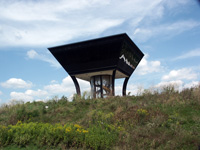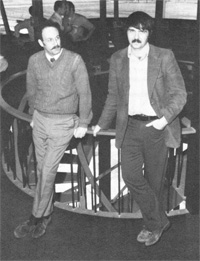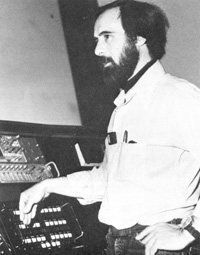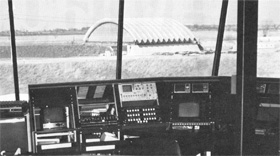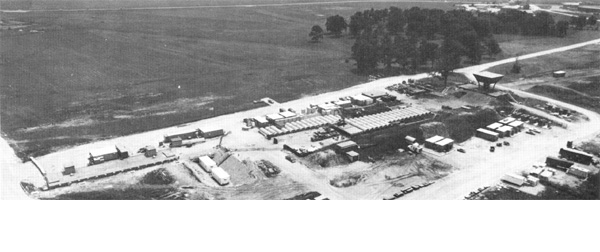Proton Area Opens Pagoda Control Center
The last major component in the original design of the Proton Experimental Area was formally opened this week. The Pagoda housing the control center for the Proton Area was launched by the twist of a dial by Director Robert R. Wilson at a noon-hour ceremony Wednesday, February 25, 1976.
The Pagoda is glassed on four sides and rises some 30 feet from the ground, making it the best place from which to see the entire outlying experimental areas. From the vantage point of the control deck of the Pagoda a 360° view is possible. But the three experimental halls controlled from the Pagoda -- P-East, P-Center, and P--West -- lie buried deep underground.
The Proton Area takes the primary proton beam from the accelerator with full intensity and energy. Experiments using the primary proton beam are located in three pits, identifiable at ground level only by the scalloped roofs over the top of what is actually a giant labyrinth. Two secondary beams are also generated by the Proton Area, the tagged photon beam and the broad band photon beam. Three crews of operators work around the clock in the Pagoda guiding the beam from the accelerator into the Proton Area facilities and into the three experiments running here simultaneously.
Direction of the Proton Area changed hands this week as Brad Cox became Proton Department Head, succeeding Roy Rubinstein who had held the position for the past 12 years. During this period, the Area has grown considerably; it also has changed its main emphasis from construction to operation for physics experiments, of which there are now eight set up. The Tagged Photon Laboratory with its associated electron beam was brought into use; the three-way-split became operational, followed by operation of the quadrupole enclosures, and the use of the P-West Area for experiments. Several important physics discoveries have already been made in the Proton Area.
In the next few months the Proton Department will start construction of a High Intensity Pion Laboratory that will be an extension of the P-West line. The new line will contain 54 superconducting magnets -- the first superconducting beam line at Fermilab.
On November 3, 1972 a beam of 200 BeV protons was steered out of the main accelerator, through the switchyard, and cleanly down the proton experimental line which is the east-most line of the three-pronged external experimental switchyard. Focussing on a tungsten target 1/8" in diameter, that first beam was seen in the P-Central area. Within 50 feet on either side are P-West and P-East, the other two places where experimental work was carried on.
In addition to bringing the line into operation, the event also represented the complete activation of the NAL experimental areas - the Meson and Neutrino lines having previously come on the air in the past few months.
In the Proton Area, experimenters study the collisions on targets of protons which come directly from the accelerator - in contrast to the other NAL experimental areas which study secondary beams - that is, beams of particles which are first produced from collisions on targets in the particular area, then transported for study. Experiment Number 70, for instance, has already begun in the Proton Area. It is a collaboration of Columbia University, Rockefeller University, and NAL experimenters to be carried out in three phases - measurements of the production of (1) gamma rays; (2) electrons, and (3) pairs of electrons and positrons. The numbers of these particles produced as the proton beam strikes targets and the energies carried off by the new particles will be measured at a variety of angles. Data will be closely scrutinized for possible existence of exotic new particles suggested in recent years, such as the W "intermediate weak boson" or Bo "heavy photon." Five other experiments are to be housed in the Proton Area in this first wave of experimenting there, all searching for new phenomena.
The Proton Experimental Area broke ground last week for a major addition to the experimental facilities there. Known as the "Pion Area," the new facility will be situated downstream of the existing Proton West experimental area. It will provide Fermilab with a major capability for experimentation with pion and anti-proton beams of intensities and of energies available at no other laboratory, and with an electron beam with excellent spot size, intensity, and purity at energies far above that available at electron machines.
According to Brad Cox, head of the Proton Area, Phase I of the construction will see completion in June of 1977 of the farthest end of the new laboratory to the middle; Phase II will include the targetting station, the portion adjacent to P-West. More than 50 superconducting magnets will be built for the line, similar to those being developed for the Energy Doubler.
The new area will receive particles of 500-1000 BeV and with intensities as high as 1014 protons per pulse at 500 BeV. In response to the growing ecperimental interest, it will be possible in the new area to study low cross sections which produce rare effects and particles such as the psi family.



